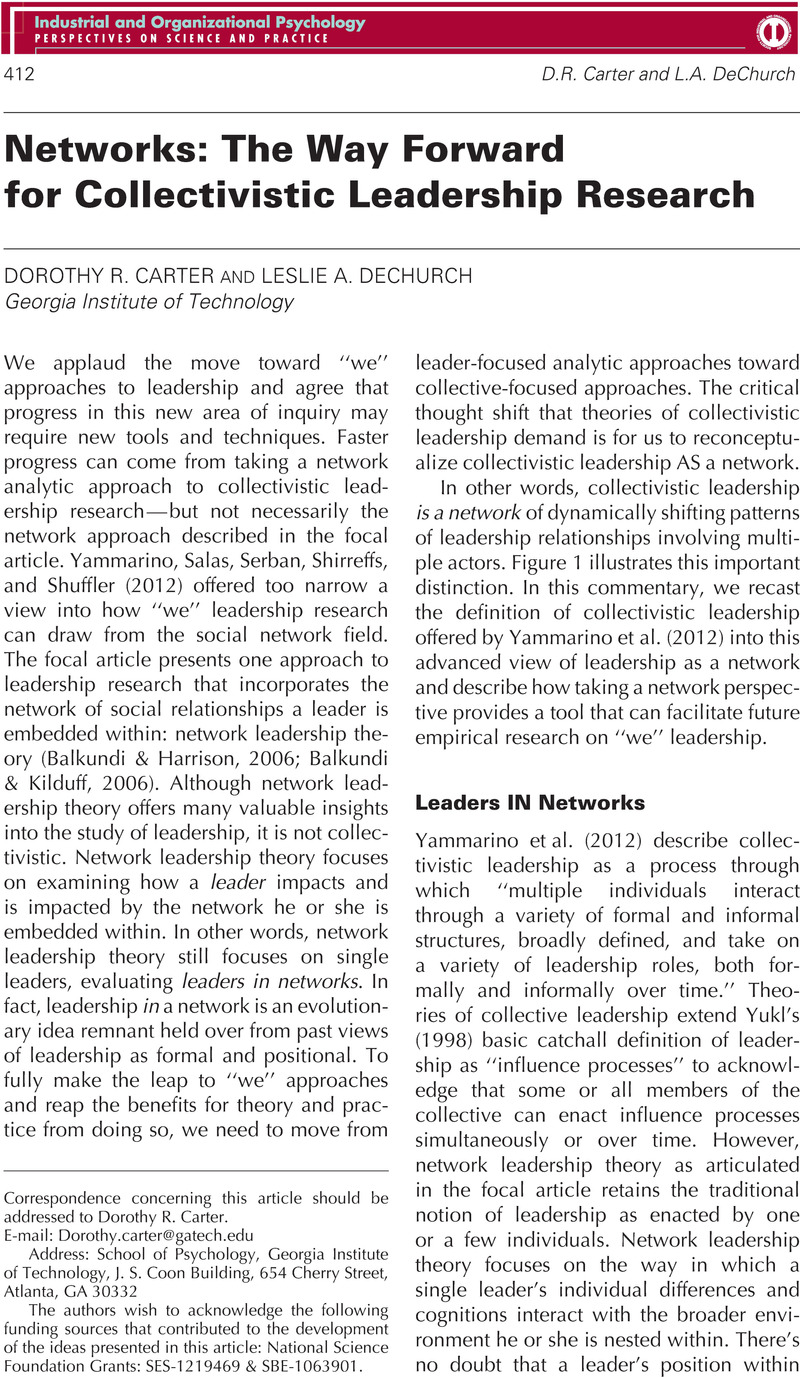Crossref Citations
This article has been cited by the following publications. This list is generated based on data provided by
Crossref.
Shuffler, Marissa L.
Salas, Eduardo
Yammarino, Francis J.
Serban, Andra
and
Shirreffs, Kristie
2012.
Putting the “We” in Leadership: Continuing the Dialogue to Advance Our Science and Practice.
Industrial and Organizational Psychology,
Vol. 5,
Issue. 4,
p.
437.
Friedrich, Tamara L.
Vessey, William B.
Schuelke, Matthew J.
Mumford, Michael D.
Yammarino, Francis J.
and
Ruark, Gregory A.
2014.
Collectivistic leadership and George C. Marshall: A historiometric analysis of career events.
The Leadership Quarterly,
Vol. 25,
Issue. 3,
p.
449.
Gronn, Peter
2015.
The view from inside leadership configurations.
Human Relations,
Vol. 68,
Issue. 4,
p.
545.
Cullen-Lester, Kristin L.
and
Yammarino, Francis J.
2016.
Collective and network approaches to leadership: Special issue introduction.
The Leadership Quarterly,
Vol. 27,
Issue. 2,
p.
173.
Drescher, Gesche
and
Garbers, Yvonne
2016.
Shared leadership and commonality: A policy-capturing study.
The Leadership Quarterly,
Vol. 27,
Issue. 2,
p.
200.
D’Innocenzo, Lauren
Mathieu, John E.
and
Kukenberger, Michael R.
2016.
A Meta-Analysis of Different Forms of Shared Leadership–Team Performance Relations.
Journal of Management,
Vol. 42,
Issue. 7,
p.
1964.
Friedrich, Tamara L.
Griffith, Jennifer A.
and
Mumford, Michael D.
2016.
Collective leadership behaviors: Evaluating the leader, team network, and problem situation characteristics that influence their use.
The Leadership Quarterly,
Vol. 27,
Issue. 2,
p.
312.
Quick, Kathryn S
2017.
Locating and building collective leadership and impact.
Leadership,
Vol. 13,
Issue. 4,
p.
445.
Gruda, Dritjon
McCleskey, Jim
and
Berrios, Raul
2018.
Seems Fair to Me: Dyadic Leader Consensus Mediates Fairness and Group Performance.
Small Group Research,
Vol. 49,
Issue. 2,
p.
195.
Hristov, Dean
Scott, Noel
and
Minocha, Sonal
2018.
Distributed leadership typologies in destination management organisations.
Tourism Management Perspectives,
Vol. 28,
Issue. ,
p.
126.
De Brún, Aoife
and
McAuliffe, Eilish
2018.
Social Network Analysis as a Methodological Approach to Explore Health Systems: A Case Study Exploring Support among Senior Managers/Executives in a Hospital Network.
International Journal of Environmental Research and Public Health,
Vol. 15,
Issue. 3,
p.
511.
Cook, Alexandra (Sasha)
Meyer, Bertolt
Gockel, Christine
and
Zill, Alexander
2019.
Adapting Leadership Perceptions Across Tasks: Micro-Origins of Informal Leadership Transitions.
Small Group Research,
Vol. 50,
Issue. 2,
p.
227.
De Brún, Aoife
O’Donovan, Roisin
and
McAuliffe, Eilish
2019.
Interventions to develop collectivistic leadership in healthcare settings: a systematic review.
BMC Health Services Research,
Vol. 19,
Issue. 1,
Cook, Alexandra (Sasha)
Zill, Alexander
and
Meyer, Bertolt
2020.
Observing leadership as behavior in teams and herds – An ethological approach to shared leadership research.
The Leadership Quarterly,
Vol. 31,
Issue. 2,
p.
101296.
De Brún, Aoife
and
McAuliffe, Eilish
2020.
Exploring the potential for collective leadership in a newly established hospital network.
Journal of Health Organization and Management,
Vol. 34,
Issue. 4,
p.
449.
Wind, Madelon E.D.
Klaster, Esther
and
Wilderom, Celeste P.M.
2021.
Leading Networks Effectively: Literature Review and Propositions.
Journal of Leadership Studies,
Vol. 14,
Issue. 4,
p.
21.





